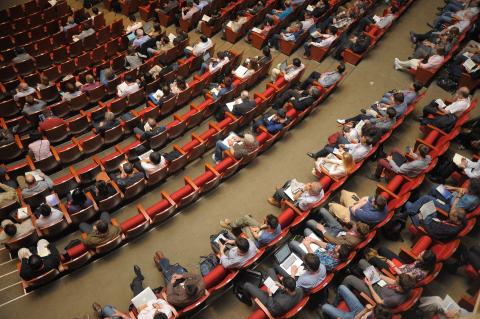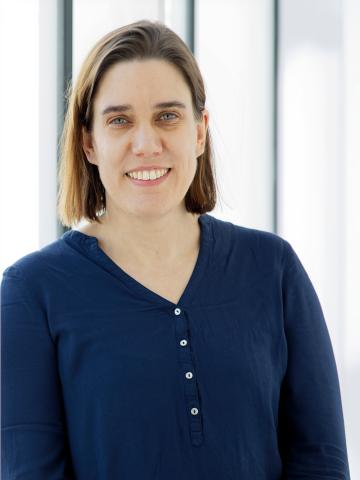
Seminars - colloquiums - Institute for the Sciences of Light

Nano-optics with fast electrons
Mathieu Kociak
mathieu.kociak@universite-paris-saclay.fr
Laboratoire de physique des solides (LPS), CNRS, Université Paris-Saclay
Hunting optical phenomena at the nanometer scale, namely performing nanooptics, is paradoxical. On the one hand, the typical length-scale relevant for optics is of the order of a visible radiation wavelength: few hundred of nanometers. On the other hand, optical properties of nano-objects become to depart from bulk properties when the nano-objects become smaller than a few hundred of nanometers. This is for example the case of plasmons in metallic nanoparticles. In this case, the optical properties depend on minute variations of the size and shape of the nano-objects. Even more, the morphology or structure of nano-objects may have to be known with atomic resolution, such as in the case of quantum dots or quantum wells. Therefore, techniques that are not limited by the optical diffraction limit have been developed in the last 15 years to make possible to study novel optical nanomaterials and the novel physics they brought.
In this talk, I will introduce a family of such techniques. They use free electron beams – such as delivered in a transmission electron microscope – to perform optical spectroscopy at the nanometer scale. I will show how they can be used to map plasmons, excitons, photonic modes and even phonons with unbeatable spatial resolution. Beyond their impressive success in generating nice images, I will show how it is now possible to quantitatively understand such experiments in pure optical terms, such as extinction and scattering cross-sections or electromagnetic local density of states. Then, I will present the use of free electron beams to perform quantum optical measurements, and introduce very recent techniques that ally the spatial resolution offered by free electrons and the spectral resolution given by lasers.
- 23 May 2024 at 11am in the AUDITORIUM of the l'Institut d’Optique, 2 Av. Augustin Fresnel, 91127 Palaiseau
To attend the conference remotely: https://uvsq-frzoom.us/j/98608491667?pwd=QlZ1SXF3cHBjNXlneGFLNmRjeUkvQT09

The specific characteristics of ancient materials in the light of their analyses by imaging approaches
Mathieu Thoury
mathieu.thoury@ipanema-remote.fr
IPANEMA - UVSQ, MCC, CNRS, Université Paris-Saclay.
Ancient materials cover a wide range of compounds that make up the objects of cultural heritage, archaeology, paleontology and palao-environments. Their study is motivated both by the fact that they constitute material archives that provide a better understanding of the past, and by the fact that they are objects whose preservation over time is important for their transmission. Their high degree of heterogeneity is both compositional, with materials that may be biological, mineral, metallic or hybrid, and also due to the transformations, of anthropic or natural origin, to which they have been subjected in the course of their use, or their interactions with their environment, conservation or burial, which makes them very difficult to reproduce. These specific properties have a major impact on the methodologies used to study them using imaging techniques such as synchrotron sources. With what probes, at what scales, with what sensitivity and using what markers is it possible to access relevant information associated with the historicity of these objects, and what analytical choices can be made to achieve this?
IPANEMA, in collaboration with a number of laboratories and heritage institutions, is developing methodological research aimed at implementing new photonic imaging techniques and optimised statistical processing for the study of heterogeneous systems, with the aim of identifying and exploiting markers of their physical and chemical history in order to gain a better understanding of their past (manufacture/synthesis, use and alteration) and anticipate their future evolution. The intersection of these studies, carried out for example on 20th century works of art, Mesopotamian archaeological artefacts and fossil specimens associated with the Permian/Triassic crisis, has also led to epistemological reflection on the experimental practices developed, as well as a reflective approach linking interdisciplinary practice, methodological developments and to study common properties to these systems. The aim of this presentation will be to present research work illustrating the reciprocal inspirations between the optimisation of novel imaging methods and the study of the multi-scale heterogeneity of specific ancient systems, in order to gain a better understanding of long-term alteration processes, the key stages in fossilisation trajectories, or exceptional conservation, with the aim of enriching our knowledge of the past.
- 15 March at 11:00 am in the AMPHITHEATER of the Institute of Optics (2 Av. Augustin Fresnel, 91120 Palaiseau)
To attend the conference remotely:
https://uvsq-fr.zoom.us/j/93278538439?pwd=T1pJT2l1bkxuaFBEWGMzd045UDlFdz09

Attosecond pulses for studying ultrafast electron dynamics
Anne L’Huilier
Division of Atomic Physics, Department of Physics, Université de Lund, Suède.
Extreme Ultraviolet light sources based on high-order harmonic generation in gases are now used in many areas of science. The radiation consists of a train of extremely short light bursts, in the 100-attosecond range, allowing for outstanding temporal resolution. This presentation will give a short historical perspective on this field of research and an introduction to the physics of these XUV sources.
Attosecond pulses have enabled the study of photoionization of atoms and molecules in a completely new way. Through the availability of synchronized probe fields and interferometric measurements, it has become possible to measure the incredibly small-time delay in photoionization, a concept introduced by E. Wigner in 1955, and to characterize the quantum state of a photoelectron.
- 29 June 2023 à 11h in the Auditorium of the Institute of Optics, 2 Av. Augustin Fresnel, 91127 Palaiseau

Silicon photonics in the mid-infrared spectral range for sensing application
Delphine Morini
delphine.morini@universite-paris-saclay.fr
Centre for Nanoscience and Nanotechnology - Université Paris Saclay - CNRS
Mid-infrared (mid-IR) spectroscopy is a nearly universal way to identify chemical and biological substances, as most of the molecules have their vibrational and rotational resonances in the mid-IR wavelength range. Commercially available mid-IR systems are based on bulky and expensive equipment, while lots of efforts are now devoted to the reduction of their size down to chip-scale dimensions. The demonstration of mid-IR photonic circuits on silicon chips will benefit from reliable and high-volume fabrication to offer high performance, low cost, compact, low weight and power consumption photonic circuits, which is particularly interesting for mid-IR spectroscopic sensing systems that need to be portable and low cost. Among the different materials available in silicon photonics, Germanium (Ge) and Silicon-Germanium (SiGe) alloys with a high Ge concentration are particularly interesting because of the wide transparency window of Ge up to 15 μm.
In this context, recent works on the development of graded-SiGe photonic integrated circuits will be presented. First passive devices will be reviewed. It will be shown that graded-SiGe waveguides can be used in an unprecedent spectral range, up to 11 μm wavelength. Mach Zehnder interferometers, resonators and integrated Fourier transform spectrometers will be reviewed. Then, the demonstration of large bandwidth optical source on chip based on non-linear optical effects of SiGe waveguides, and the realization of optoelectronic devices (modulator and photodetector) will be presented.
- 13 June 2023 à 11h in the Auditorium of the Institute of Optics, 2 Av. Augustin Fresnel, 91127 Palaiseau

Artificial photosynthesis
Ally Aukauloo
ally.aukauloo@universite-paris-saclay.fr
ICMMO, Université Paris-Saclay
Photosynthesis is the process that uses sunlight as sole energy input to flush carbon dioxide (CO2) from our atmosphere and convert it into a chemical energy vector. Chemists worldwide are devoting much effort to develop advanced materials that can capture light to activate and transform very stable molecules i.e., water and carbon dioxide, the key ingredients, into energy rich molecules. I will discuss on the three aspects of Capturing photons, Converting them into a chemical potential and performing multi-electron Catalysis, the three Cs of Artificial Photosynthesis research.
La photosynthèse est le processus qui utilise la lumière du soleil comme unique apport d'énergie pour chasser le dioxyde de carbone (CO2) de notre atmosphère et le convertir en un vecteur d'énergie chimique. Les chimistes du monde entier consacrent beaucoup d'efforts au développement de matériaux avancés capables de capter la lumière pour activer et transformer des molécules très stables, à savoir l'eau et le dioxyde de carbone, les ingrédients clés, en molécules riches en énergie. Je discuterai des trois aspects de la capture des photons, de leur conversion en un potentiel chimique et de la réalisation d'une catalyse multi-électronique, les trois C de la recherche sur la photosynthèse artificielle.
- 16 February 2023 à 11h in the Auditorium of the Institute of Optics, 2 Av. Augustin Fresnel, 91127 Palaiseau

The Webb telescope: a giant in space
Pierre-Olivier Lagage
Astrophysicist at CEA Paris-Saclay
On 25 December 2021, the Webb telescope, the largest and most complex ever built, was launched from Kourou by an Ariane 5 rocket. Two weeks later, the telescope was fully deployed, and by the end of January it was in orbit around Lagrange point L2 (1.5 million km from Earth). The 18 hexagons that make up the primary mirror were then phased and the four instruments put into service. In many respects, performance has been better than required and the best we could have hoped for. Scientific observations began in July. Thanks to its vast collecting surface (25 square metres) and wide wavelength coverage (from 0.6 to 28 microns), this flagship mission by NASA, with the participation of Europe and Canada, will have an impact on many areas of astrophysics. It will enable us to observe farther back than Hubble and probe the Universe at the time when the first galaxies formed, a few hundred million years after the big bang. It will also allow us to probe the regions where stars form with unprecedented acuity. Another example of the fields that will benefit from Webb observations is the study of exoplanets. During the seminar, I will present Webb's performance and initial results, focusing on exoplanets.
- 10 January 2023 à 11h in the Auditorium of the Institute of Optics, 2 Av. Augustin Fresnel, 91127 Palaiseau
Last year seminars - colloquiums 2022

Exceeding the diffraction limit in fluorescence microscopy
Sandrine Lévêque-Fort
sandrine.leveque-fort@universite-paris-saclay.fr
Institut des sciences Moléculaires d’Orsay, Université Paris Saclay, CNRS, 91405 Orsay
Fluorescence microscopy is a reference tool in the study of biological systems, combining the specificity offered by fluorescence with the possibility of morphological and functional monitoring in vivo. Recent developments, which have been awarded the Nobel Prize in Chemistry, have made it possible to go beyond the diffraction limit and access information on a nanometric scale that was previously inaccessible. In particular, single-molecule localisation techniques (PALM/STORM)(1-3) have made it possible to achieve lateral localisation accuracies of a few nanometres. However, as with all super-resolution techniques, improvement in the axial direction remains a major challenge if we are to move towards a nanoscope with isotropic resolution that is also capable of imaging at depth (several tens of microns)(4).
After an introduction to the field, I will present various developments carried out at ISMO to meet this need for quantitative 3D imaging, illustrated by different biological applications. In particular, we are making direct use of the intrinsic properties of fluorophores, such as their near-field properties, to localise them axially(5-7) and thus address issues such as cell adhesion. To position individual fluorescent emitters at great depth (several tens of microns), we use a different strategy, based on the introduction of a time-modulated excitation that locates the fluorophores via the phase of their modulated signal with uniform precision below 7 nm(8).
I will conclude by discussing the current prospects in this field, and will also show that, in addition to applications in biology, the localisation of single molecules can also be used to observe nanostructured materials (9, 10).
References :
1. W. E. Moerner, Accounts of Chemical Research 29, 563–571 (1996).
2. S. T. Hess, et al., Biophysical Journal 91, 4258–4272 (2006).
3. M. J. Rust, et al., Nature Methods 3, 793–796 (2006).
4. A. von Diezmann, et al., Chemical Reviews 117, 7244–7275 (2017).
5. N. Bourg, et al., Nature Photonics 9, 587–593 (2015).
6. C. Cabriel, et al., Nature Commun 10, 1–10 (2019).
7. T. Orré, et al., Nature Commun 12, 3104 (2021).
8. P. Jouchet, et al., Nature Photonics, 1–8 (2021).
9. G. Cattinari, et al., ACS Appl. Nano Mater. 4, 6722–6733 (2021). 10. A. F. Koenderink et al., Nanophotonics, 11, 169 (2022).
- 14 September 2022 à 11h in the Auditorium of the Institute of Optics, 2 Av. Augustin Fresnel, 91127 Palaiseau

Watching atoms and electrons in action with HHG and short wavelength free electron laser sources
Kiyoshi UEDA
Tohoku University, Sendai, Japan
The present talk will illustrate the current status of short-wavelength free-electron laser (FEL) experiments, focusing on characteristic properties of different facilities and compare them with laboratory-based HHG source experiments. The advent of hard x-ray FELs, such as SACLA in Japan, opened a route to extract the structure of a single nanoparticle [1] and its change upon the intense laser irradiation, which transforms the nanoparticle into a nanoplasma [2]. The first high repetition rate soft x-ray FEL, the European XFEL, combined with a Reaction Microscope/COLTRIMS, made the long-standing dream to watch atoms in action - initiated by photoexcitation of a molecule - a tangible reality, using the so-called core-level photoelectron diffraction technique for fixed-in-space molecules [3]. Generation of two-color attosecond pulse pairs at the LCLS in the USA finally opened the door to watching charge migration in a molecule, before the nuclear dynamics sets in, with an attosecond transient absorption technique based on the detection of resonant Auger electrons [4]. Generating phase-coherent multi-color pulses at FERMI, on the other hand, provided a novel approach to coherently control the electronic wave-packets [5] and to read out the photoionization phase [6]. One can also directly access the energy dependent photoionization phases, or the photoionization time delays, by using the RABBITT technique with a laboratory-based HHG source, or attosecond pulse trains, which could also be used for studying the attosecond trapping of photoelectrons by the molecular shape resonances [7]. These works were carried out by a wide range of international collaborations. I acknowledge all the collaborators in the authors list of [1-7] for fruitful collaborations.
References :
[1] A. Niozu et al., IUCrJ 7, 276 (2020); A. Niozu et al., PNAS 118, e2111747118 (2021).
[2] T. Nishiyama et al., PRL 123, 123201 (2019); A. Niozu et al., PRX 11, 031046 (2021).
[3] G. Kastire et al., PRX 10, 021052 (2020).
[4] T. Barillot et al., PRX 11, 031048 (2021).
[5] K. Prince et al., Nature Photonics 10, 176 (2016); D. Iablonskyi et al., PRL 119, 073203 (2017).
[6] M. Di Fraia et al., PRL 123, 213904 (2019); D. You et al., PRX 10, 031070 (2020).
[7] X. Dong et al., PRX 12, 011002 (2022).
- 28 June 2022 à 11h at LIDYL, CEA Paris-Saclay, L'Orme des Merisiers, Bât 701, salle 17C, 91191 Gif-sur-Yvette
To attend the meeting via zoom:
https://cnrs.zoom.us/j/93622375451?pwd=b0lUR2xWRUpHU1htZVVBV3dONW1vdz09

Pollution/Climate: What can the IASI infrared sounder see from space?
Cathy Clerbaux
LATMOS/IPSL, UVSQ Université Paris-Saclay, Sorbonne Université, CNRS, Guyancourt, France
The IASI infrared sounder, built by CNES, has been flying on board the 3 Metop satellites since 2006. After more than 15 years in orbit, the results of the IASI mission, in terms of scientific and technological return and societal impact, are impressive. The meteorological services have established that it is the best weather sounder ever developed, making an essential contribution to the quality of weather forecasts. IASI is also the only instrument that simultaneously measures around twenty atmospheric compounds twice a day at any point on the globe, in real time.
The presentation will give examples of recent advances in monitoring atmospheric composition: observations are used to monitor pollution peaks over the Ile de France, gas plumes escaping from China, major fires raging in summer, ammonia emissions associated with intensive agriculture (first mapping carried out from space), exceptional meteorological episodes, and the formation of the hole in the ozone layer. IASI has also played an important role in providing data that can be used to issue early warnings of volcanic eruptions, to prevent aircraft from overflying areas contaminated by ash, or to set up evacuation alerts for local populations.
- 19 May 2022 à 11h in the Auditorium of the Institute of Optics, 2 Av. Augustin Fresnel, 91127 Palaiseau

Polaritons in semiconductor lattices: emulating condensed matter physics
Jacqueline Bloch
jacqueline.bloch@universite-paris-saclay.fr
Center for Nanoscience and Nanotechnology, C2N / Université Paris Saclay / CNRS, Palaiseau, France
Photonic resonators, coupled within a lattice, have appeared in the recent years as a powerful synthetic platform to imprint on light some of the fascinating physical properties that can emerge in condensed matter, or even to go beyond what exists in nature. For instance, light can become superfluid, present spin orbit coupling, spin Hall effect or propagate along topologically protected edge states. New physical properties may emerge when drive and dissipation come into play. Such realizations are not only interesting from a fundamental point of view, but also inspire innovative photonic devices.
After a general introduction to polariton physics and polariton lattices [1], I will present some recent experiments we have performed at C2N. Using lattices of semiconductor microcavities, we explore single and many body physics of photons in 1D or 2D lattices and the emergence of novel physics related to the openness of the system [2]. Topological physics can be investigated when non-linearities come into play[3]. Interestingly, our photonic platform also enables exploring universal scaling related to the Kardar–Parisi–Zhang universality class [4].
References :
[1] Ciuti and I. Carusotto, Quantum fluids of light, Rev. Mod. Phys. 85, 299 (2013).
[2] A. Amo and J. Bloch, Exciton-polaritons in lattices: A non-linear photonic simulator, Comptes Rendus de l’Académie des Sciences 8, 805 (2016) (Elsevier).
[3] N. Pernet et al., Topological gap solitons in a 1D non-Hermitian lattice, arXiv:2101.01038 (to appear 2022).
[4] Q. Fontaine et al., Observation of KPZ universal scaling in a one-dimensional polariton condensate, arXiv:2112.09550 (2021).
- 22 April 2022 à 11h in the Auditorium of the Institute of Optics, 2 Av. Augustin Fresnel, 91127 Palaiseau

Rise of the Machines: Making better photons by getting rid of experimentalists
Andrew White
Jihun Cha , Sebastian Malewicz , Fatemeh Mohit , Marcelo Alemida , Till Weinhold , and Andrew White
Centre for Engineered Quantum Systems , School of Mathematics and Physics , University of Queensland, Brisbane 4072, Australia
There is now an enormous opportunity to interconnect quantum components together into complex short and long range networks of sensing communication, and computational elements Photons are a natural choice for networking quantum technologies as their quantum nature survives at room temperature and long distance propagation is possible, either via optical fibre or through free space.
Here we explore using machine learning ( to optimise production, coupling routing and circuitry for single photons Our single photon source platform is resonant excitation of individual quantum dots coupled to a micropillar cavity Multiphoton suppression in the quantum dot emission as well as single photon indistinguishability and brightness are directly influenced by the spatiotemporal characteristics of the optical excitation pulses We use ML techniques to tailor the excitation laser pulse properties in real time, significantly reducing the search time for optimal parameters We also employ ML to control a deformable mirror correcting for aberration on the single photon wavefront field to maximise the coupling between the source output and a single mode fibre This combination provides a toolbox for enhancing the performance of any solid state single photon source.
Photonic integrated circuits ( will be essential for scalaby realising photonic quantum technologies Actively coupling photons into PICS requires high fidelity integrated switches Current best practice manual optimisation of electronic signals for each individual switch on a chip is slow and unscalable We use ML simulated annealing to optimise driving parameters for up to 4 switches on a single chip, achieving a significant speed up in tuning while retaining optimal performance PICS often interface light in and out of the chip using edge coupling which severely limits chip geometry as well as adding complication to fabrication Using ML inverse design we are developing efficient out of plane couplers and small footprint waveguide crossings that are easier to manufacture and have higher circuit density This new architecture lowers entry costs for photonic integrated circuitry development.
- 25 March 2022 à 14h in the Auditorium of the C2N - Centre de nanosciences et de naotechnologies, Palaiseau.

EUV imaging to explore the Sun: initial results from the Solar Orbiter space mission
Frédéric Auchère
Astronomer
frederic.auchere@universite-paris-saclay.fr
Institut d'Astrophysique Spatiale
Ultraviolet and Extreme Ultraviolet (UV/EUV) imaging and spectroscopy are essential tools for astrophysics. The solar and stellar cores are plasmas heated to temperatures of the order of a million degrees, emitting numerous emission lines in this range of the spectrum. The Solar Orbiter mission, successfully launched in February 2020, will carry several UV/EUV instruments, produced with a major contribution from French laboratories. The unique characteristics of the probe's orbit will take it to 0.29 astronomical units and 35° inclination to the ecliptic plane, providing unprecedented views of our star. We'll be looking at the main features of the instruments used and the initial results already obtained, including some of the most detailed images ever taken of the Sun's corona.
- 15/03/2022 à 11h in the Auditorium of the Institute of Optics (2 Av. Augustin Fresnel, 91120 Palaiseau)
To attend the seminar via zoom click here

Bright and Fast: Lasers to Capture the Dance Between Electrons and Nuclei in Molecular Systems
Nora Berrah
University of Connecticut, Physics department, Storrs, CT, USA
Groupe AttoPhysique, LIDYL, Université Paris-Saclay, CEA, CNRS, France
Photoionization of atoms, molecules, and small complexes creates a fundamental testing ground to understand better quantum mechanical phenomena arising from the interaction of photon with matter. With the ultrafast (~10-15 s) light sources, such as lab-based tabletop lasers and facility-based free electron lasers (FELs), one can investigate molecular processes in the time domain, thus mapping out their evolution. In that regard, it is possible to “make a molecular movie” of ultrafast reaction dynamics. In the seminar, we will present some of our work using photons in the XUV and X-ray regime from the Linac Coherent Light Source (LCLS) FEL at SLAC National Laboratory as well as the FLASH FEL in Hamburg, Germany.
- February 22 at 11:00 am in the Auditorium of the Institute of Optics (2 Av. Augustin Fresnel, 91120 Palaiseau)

